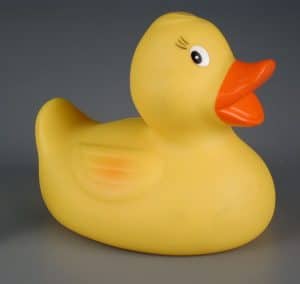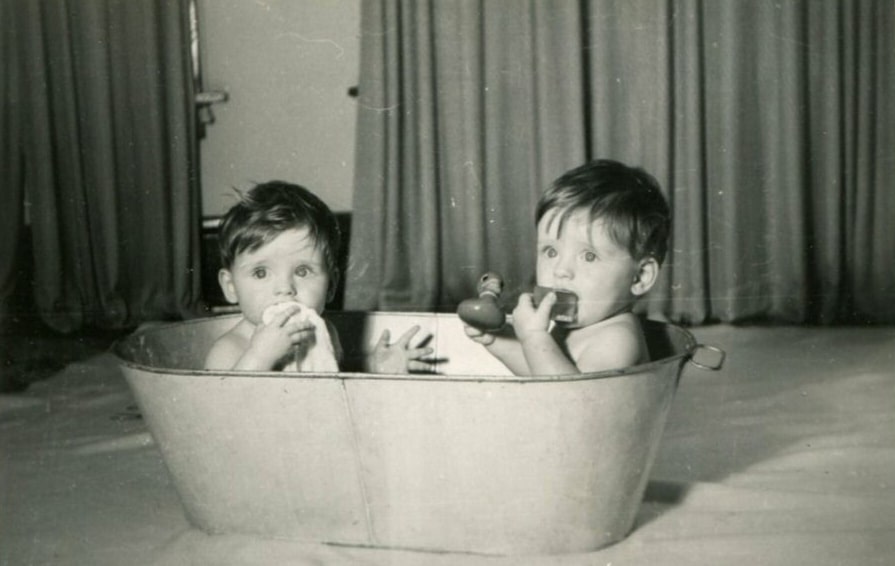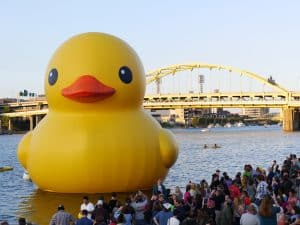Bet I can make you smile with just two words: rubber duck.
 You did, didn’t you? You can’t help but smile. This will make you smile too. On November 7, the rubber duck—along with the game of chess—joined 51 other classic toys inducted in the National Toy Hall of Fame at The Strong. How did such a simple toy become the object of such high honors? It is an interesting tail, I mean tale.
You did, didn’t you? You can’t help but smile. This will make you smile too. On November 7, the rubber duck—along with the game of chess—joined 51 other classic toys inducted in the National Toy Hall of Fame at The Strong. How did such a simple toy become the object of such high honors? It is an interesting tail, I mean tale.
 Rubber toys first appeared in the late 1800s, but it took several decades before a floatable figure of a yellow fowl took over water play. Over the years, the toy’s design has evolved into the swimming duck with the bright orange beak we recognize today. These days, of course, rubber ducks are no longer made of rubber; most are molded of vinyl, but the familiar name and figure recall cheerful images of infants and toddlers frolicking at bath time. The duck’s bright colors, smooth texture, and (for some) squeaky or quacky sound sharpen toddlers’ senses. Playing with a rubber duck, especially squeezing it, builds hand muscles and hand-eye coordination. The toy’s presence in the bathtub soothes youngsters’ fears of water immersion and makes good fun of the routine hygiene they’re learning.
Rubber toys first appeared in the late 1800s, but it took several decades before a floatable figure of a yellow fowl took over water play. Over the years, the toy’s design has evolved into the swimming duck with the bright orange beak we recognize today. These days, of course, rubber ducks are no longer made of rubber; most are molded of vinyl, but the familiar name and figure recall cheerful images of infants and toddlers frolicking at bath time. The duck’s bright colors, smooth texture, and (for some) squeaky or quacky sound sharpen toddlers’ senses. Playing with a rubber duck, especially squeezing it, builds hand muscles and hand-eye coordination. The toy’s presence in the bathtub soothes youngsters’ fears of water immersion and makes good fun of the routine hygiene they’re learning.
 The rubber duck’s image as the quintessential tub toy was sealed in 1970 when Ernie, the cheerful orange Muppet of Sesame Street, sang “Rubber Duckie,” and the catchy tune rose to number 16 on the Billboard charts. Decades later, kids still sing the praises of their best bath buddies. The iconic rubber duck has gone on to become a universally recognized symbol for infants, children, bathing, and bathrooms; a tool for teaching developmental and cognitive skills to infants; a cheerful motif for decorating floor mats, wallpaper, nightlights, and all manner of consumer goods; a popular theme for baby showers and toddler birthday parties; and a frequent and friendly character in children’s books and stories. Adults appreciate rubber ducks too. The toys recall the innocent, silly fun of their childhood, and grown-ups can’t seem to stop themselves from using ducks in parody, puns, and practical jokes (all in squeaky clean fun, of course).
The rubber duck’s image as the quintessential tub toy was sealed in 1970 when Ernie, the cheerful orange Muppet of Sesame Street, sang “Rubber Duckie,” and the catchy tune rose to number 16 on the Billboard charts. Decades later, kids still sing the praises of their best bath buddies. The iconic rubber duck has gone on to become a universally recognized symbol for infants, children, bathing, and bathrooms; a tool for teaching developmental and cognitive skills to infants; a cheerful motif for decorating floor mats, wallpaper, nightlights, and all manner of consumer goods; a popular theme for baby showers and toddler birthday parties; and a frequent and friendly character in children’s books and stories. Adults appreciate rubber ducks too. The toys recall the innocent, silly fun of their childhood, and grown-ups can’t seem to stop themselves from using ducks in parody, puns, and practical jokes (all in squeaky clean fun, of course).
 No wonder Dutch artist Florentijn Hofman chose a giant rubber duck to communicate a sense of delight and mirth in a world tour of his inflatable sculpture, which he called “Spreading Joy around the World.” Imagine the sight of a six-story tall version of a classic childhood toy floating among luxury yachts, huge barges, or container ships in the waters of Hong Kong, Auckland, Sidney, and Pittsburgh.
No wonder Dutch artist Florentijn Hofman chose a giant rubber duck to communicate a sense of delight and mirth in a world tour of his inflatable sculpture, which he called “Spreading Joy around the World.” Imagine the sight of a six-story tall version of a classic childhood toy floating among luxury yachts, huge barges, or container ships in the waters of Hong Kong, Auckland, Sidney, and Pittsburgh.
Bet that made you quack a smile, too, didn’t it?
 Hours 10 a.m.–5 p.m. | Fri. & Sat. till 8 p.m.
Hours 10 a.m.–5 p.m. | Fri. & Sat. till 8 p.m.